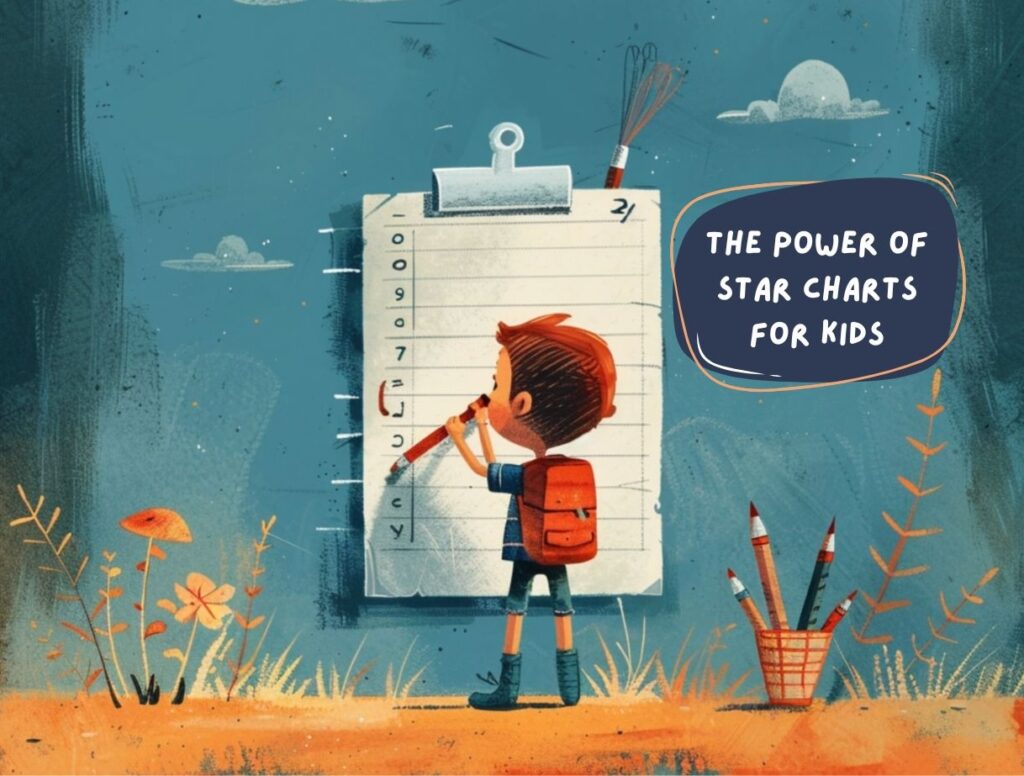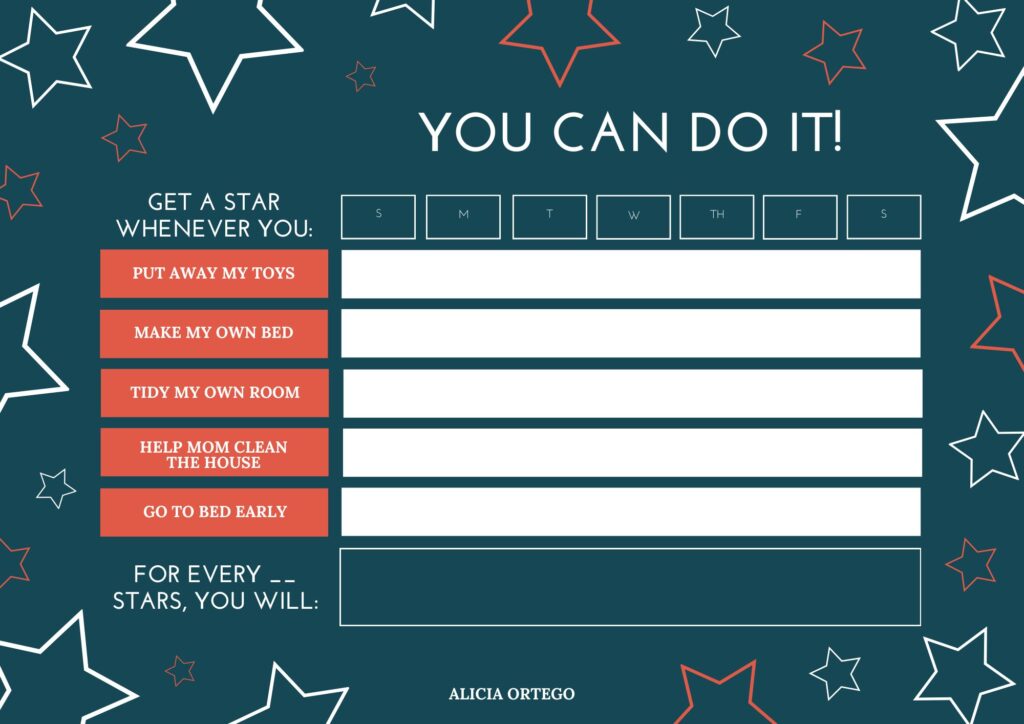The Power of Star Charts for Kids (with PDF)

In the bustling world of parenting, finding effective strategies to motivate and encourage positive behavior in children is an ongoing challenge. Enter the star chart, a simple yet powerful tool designed to foster good habits in kids by providing a visual representation of their achievements. This article explores the intricacies of star charts, delving into their purpose, creation, implementation, and the transformative impact they can have on a child’s behavior.
Understanding Star Charts
Star charts, also known as behavior charts or reward charts, serve as motivational tools for children. At their core, these charts work by visually reinforcing positive behavior through the accumulation of stars. The psychology behind this technique lies in the association between task completion and tangible rewards, creating a sense of accomplishment and motivation for kids.
Creating an Effective Star Chart
Select Appropriate Tasks for Children
Choosing age-appropriate tasks is a nuanced process that involves considering a child’s developmental stage and abilities. This ensures that the tasks are neither too challenging nor too easy, promoting a sense of accomplishment. Aligning tasks with specific behavioral goals is a strategic approach that emphasizes responsibility and personal development. For instance, assigning tasks related to organization or self-care can instill habits that contribute to a child’s overall growth.
Design a Visually Appealing Star Chart
Creating a visually appealing star chart is essential for capturing a child’s attention and maintaining their interest. The use of vibrant colors and engaging graphics not only makes the chart aesthetically pleasing but also stimulates visual interest. Personalization is key to enhancing the child’s connection with the chart. Including elements such as their favorite colors, characters, or themes creates a sense of ownership, making the chart more meaningful to the child.
Set Achievable Goals and Rewards
Balancing difficulty and attainability in task selection is crucial to prevent frustration. Tasks that are too challenging may lead to discouragement, while overly simple tasks may not provide a sufficient sense of achievement.
Tailoring rewards to the child’s interests is an integral part of the process. Understanding what motivates the child ensures that the rewards are meaningful and effective incentives. Whether it’s extra playtime, a special treat, or a small privilege, the rewards should align with the child’s preferences to maximize their motivational impact.
Free Printable “Power Star Chart” PDF

Implementing the Star Chart System
Introducing the Concept to the Child. Clearly explaining the purpose of the star chart and how it relates to their behavior is a crucial first step. By providing a straightforward and age-appropriate explanation, parents can ensure that children grasp the concept behind the star chart. Encouraging open communication about the expectations and benefits of using the chart fosters a sense of understanding and cooperation.
Explaining the Correlation Between Tasks, Stars, and Rewards. Establishing a direct connection between completing tasks, earning stars, and receiving rewards is fundamental for the effectiveness of the star chart. This step helps children understand the cause-and-effect relationship between their actions and the positive outcomes they desire. Reinforcing this relationship is key to motivating children to consistently engage in desired behaviors.
Free Printable “Power Star Chart” PDF

Consistency in Tracking and Acknowledging Achievements. Ensuring regular updates to the star chart to reflect the child’s progress is vital for maintaining its impact. Consistency in tracking accomplishments reinforces the visual representation of the child’s efforts. Promptly acknowledging and celebrating achievements is equally important. This positive reinforcement not only validates the child’s hard work but also serves as a continual source of motivation, reinforcing the connection between tasks and rewards.
Monitore Progress
Regularly Updating the Star Chart. Consistently track and document the child’s achievements to maintain an accurate representation of their progress. The star chart, when regularly updated, becomes a dynamic and evolving tool that adapts to the child’s changing needs. This continuous tracking ensures that the chart remains relevant and effective in reinforcing positive behaviors.
Identifying Patterns and Adjustments. Recognizing patterns in behavior is crucial for understanding the child’s challenges and successes. Addressing challenges promptly allows for a proactive approach to behavioral adjustments. Making necessary adjustments to tasks, goals, or rewards based on the child’s evolving preferences and capabilities ensures that the star chart remains a tailored and responsive tool.
Celebrating Milestones and Achievements. Designating special celebrations for significant milestones reinforces positive behavior. Beyond the stars and rewards, acknowledging and celebrating achievements fosters a sense of pride and accomplishment in the child. These celebrations contribute to the overall positive experience associated with the star chart.
Free Printable “My Weekly Rewards” PDF

Address Challenges
Dealing with Setbacks and Lack of Motivation. Offering support and understanding during periods of difficulty is essential. Acknowledging setbacks as part of the learning process encourages resilience and perseverance in the face of challenges. This approach helps maintain the child’s motivation and prevents discouragement.
Modifying the Star Chart System Based on the Child’s Evolving Needs. Remaining flexible and open to modifications is crucial for adapting the star chart system to the child’s development. Soliciting feedback directly from the child ensures that the chart remains engaging and effective. This collaborative approach empowers the child to actively participate in their behavior modification process.
Involving Parents and Caregivers in the Process. Promoting open communication between parents, caregivers, and the child regarding the star chart is key to its success. Collaborating ensures consistency in expectations and rewards across different environments, reinforcing the positive behaviors encouraged by the star chart both at home and in other settings.
Free Printable “My Weekly Rewards” PDF

Case Studies
Explore real-life examples of families who have successfully implemented star charts, highlighting challenges faced and overcome. Gather testimonials and feedback from parents and children, showcasing the diverse ways in which star charts have positively impacted behavior.
Insights from Child Psychologists on Effectiveness
Incorporating insights from child psychologists adds a valuable layer of expertise to the discussion of star charts for kids. These professionals shed light on the psychological underpinnings and the effectiveness of using star charts as behavior modification tools.
1. *Dr. Samantha Rodriguez, Child Behavior Specialist*
“The Power of Positive Reinforcement” Dr. Rodriguez emphasizes that star charts harness the principle of positive reinforcement. “Children thrive on positive feedback and rewards. Star charts provide a tangible representation of their accomplishments, reinforcing the desired behaviors over time.”
2. *Dr. Michael Thompson, Child Psychologist*
“Building Self-Esteem” Dr. Thompson highlights the role of star charts in building a child’s self-esteem. “Children gain a sense of achievement as they see their progress visually. It helps build confidence and a positive self-image, making them more likely to continue positive behaviors.”
3. *Prof. Emily Harris, Child Development Expert*
“Teaching Goal-setting” Prof. Harris discusses the educational aspect, stating, “Star charts teach children the importance of setting and achieving goals. This valuable skill carries over into various aspects of their lives, fostering a sense of responsibility and accomplishment.”
Conclusion
In conclusion, the article emphasizes the numerous benefits of utilizing star charts for kids. It underscores the long-term impact on cultivating good habits and encourages parents and caregivers to explore this effective and rewarding tool for behavior modification. By unlocking the power of star charts, families can create a positive and supportive environment that nurtures the development of responsible and motivated individuals.
More articles

Tips for Parents to Boost Their Child’s Communication Skills at Home
Effective communication forms the foundation of a child’s academic success, social relationships, and emotional well-being. However, for many children, mastering these skills presents a significant challenge. According to recent data, nearly 1 in 12 U.S. children aged 3–17 has experienced a disorder related to voice, speech, language, or swallowing within the past year. Among them, […]

Helping Kids Who Struggle to Sit Still and Stay Calm
Some children move through the world with nonstop energy that rarely seems to slow down. They bounce, fidget, tap their feet, or speak out when quiet is expected. These behaviors can feel overwhelming for parents, teachers, and caregivers trying to create calm. Is the child being defiant or simply overstimulated? Are they anxious, under-challenged, or […]

Teaching Kids to Celebrate Differences Through Books
Why Books Matter in Teaching Kids About Differences Teaching kids to celebrate differences through books is one of the most effective and natural ways to build a more inclusive future. Stories have long served as windows into other lives, cultures, and perspectives. When children read books that highlight diversity, inclusion, and empathy, they begin to […]



